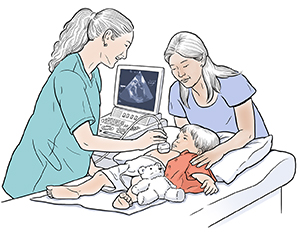Echocardiography for Children
What is echocardiography for children?

Echocardiography is an imaging test. It uses sound waves to make detailed pictures of the heart.
The test can be done in two ways.
Transthoracic echo (TTE). This method uses a hand-held wand called a transducer. The healthcare provider moves it across the chest over the area where the heart is. The transducer sends and receives sound waves that are changed into images.
Transesophageal (TEE) echo. The test may be done by passing a transducer down through the esophagus. The esophagus is the tube leading from the throat to the stomach. Because the esophagus sits right behind the heart, TEE provides better imaging detail than the transthoracic echo.
Intracardiac echocardiography (ICE). This type of echocardiography is done with probes as part of a cardiac catheterization and does not require general anesthesia as TEE sometimes does.
Most echocardiography is 2-D. Two views of the heart are used to create the images. Other types include:
Doppler. This shows blood flow through the heart.
Color Doppler. This shows color images to better see blood flow.
3-D. This gives 3 views of the heart.
Stress echocardiography. This shows what the heart does under stress from medicine or exercise.
Why might my child need echocardiography?
Echocardiography is an important imaging test for heart problems in infants and children. It may help diagnose problems your child was born with (congenital). Or it may help diagnose a problem that has developed (acquired). Below are reasons for having echocardiography.
Congenital
Signs or symptoms that may mean a heart problem. These might be a bluish color of the skin (cyanosis) or a heart murmur.
Checking the heart because of other congenital problems related to it
Family history of congenital heart disease
Other abnormal test results
Acquired
Infections or other conditions that may affect the heart
High blood pressure
Irregular heartbeats
What are the risks of echocardiography for a child?
Echocardiography does not have any risks. If you child needs relaxation medicine (sedation), there may be a small risk for problems. If your child is having sedation, talk with his or her provider.
How do I get my child ready for echocardiography?
Your child won’t need to do anything special before an echocardiogram.
If your child is old enough to understand, explain that he or she will have to lie still to have pictures taken.
He or she may have medicine to go to sleep for a transesophageal echo. It’s sometimes needed for transthoracic echo, especially for younger children.
Make sure your child knows that the procedure doesn’t cause pain.
Most of the time, you can stay with your child during the exam.
Your child may also be able to hold a toy or watch TV or a movie during the exam.
For any special instructions, talk with your child’s provider or the facility.
What happens during echocardiography for a child?
The echo may be done in a cardiologist’s office, at a hospital, or at an imaging facility. It takes about 45 to 60 minutes for a transthoracic echo. A specially trained technician (cardiac sonographer) usually does the test. The steps are:
Your child will lie down on an exam table in a room with the lights dimmed.
The technician will put gel on your child's chest to help the transducer move.
The technician will put the transducer on the chest and move it around to get the heart images. Your child will feel slight pressure of the probe as it’s moved around the chest.
The images display on a computer screen.
Your child will need sedation if he or she is having a transesophageal echo. For this test, the transducer is passed into your child’s mouth, throat, and into the esophagus. A bite protector will be placed in your child's mouth. Vital signs including heart rate, blood pressure, and oxygen levels will be monitored. Once your child is sedated enough, the TEE probe will be inserted into the esophagus. This test lasts about 15 minutes.
What happens after echocardiography for a child?
Once the test is done, the technician wipes the gel from the chest. If your child had sedation, he or she is watched until awake. A pediatric cardiologist reviews the images at some point after the exam. Depending on the results of the echo, your child may need other tests or procedures. Some children have a sore throat for a day or 2 after a TEE procedure.
Next steps
Before you agree to the test or the procedure for your child make sure you know:
The name of the test or procedure
The reason your child is having the test or procedure
What results to expect and what they mean
The risks and benefits of the test or procedure
When and where your child is to have the test or procedure
Who will do the procedure and what that person’s qualifications are
What would happen if your child did not have the test or procedure
Any alternative tests or procedures to think about
When and how you will get the results
Who to call after the test or procedure if you have questions or your child has problems
How much you will have to pay for the test or procedure
Connect with us:
Download our App: